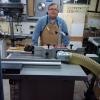Another newbie!
I,m also pretty new to woodworking.
I recently picked up an older 4" jointer with no motor and would like to know at what speed should the cutter head be turning. It has a 2" pulley on it . Should I use a 3600 rpm motor?
The same thing for a 9" rockwell table saw, the motor on it is a 1725 rpm with a 4.5" pulley .When I got it it did not have the original motor or pulley.
Thanks in advance!




 Reply With Quote
Reply With Quote




